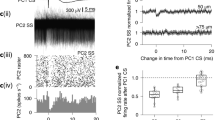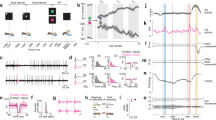Abstract
The hypothesis of cerebellar learning proposes that complex spikes in Purkinje cells engage mechanisms of plasticity in the cerebellar cortex; in turn, changes in the cerebellum depress the simple-spike response of Purkinje cells to a given stimulus and cause the adaptive modification of a motor behavior. Many elements of this hypothesis have been supported by prior experiments, and correlations have been found between complex spikes, simple-spike plasticity and behavior during the learning process. We carried out a trial-by-trial analysis of Purkinje cell responses in awake-behaving monkeys and found evidence for a causal role for complex spikes in the induction of cerebellar plasticity during a simple motor learning task. We found that the presence of a complex spike on one learning trial was linked to a substantial depression of simple-spike responses on the subsequent trial, at a time when behavioral learning was expressed.
This is a preview of subscription content, access via your institution
Access options
Subscribe to this journal
Receive 12 print issues and online access
$209.00 per year
only $17.42 per issue
Buy this article
- Purchase on Springer Link
- Instant access to full article PDF
Prices may be subject to local taxes which are calculated during checkout







Similar content being viewed by others
Change history
15 January 2009
In the version of this article initially published, two citations were inadvertently omitted. To correct this, the following two sentences were added to the second paragraph of the introduction, following the sixth sentence. "One line of work has supported the theory by demonstrating that arm movement errors evoke complex spikes51,52 and that subsequent learned changes in motor behavior are associated with suitable changes in simple spike responses51. This work demonstrates a strong correlation, but stops short of showing cause-and-effect links between individual complex spikes, changes in simple spikes and behavioral learning." Two references were also added to the reference list as follows: “51. Gilbert, P.F. & Thach W.T. Purkinje cell activity during motor learning. Brain Res. 128, 309–328 (1977). 52. Ojakangas C.L & Ebner T.J. Purkinje cell complex and simple spike changes during a voluntary arm movement learning task in the monkey. J. Neurophysiol. 68, 2222–2236 (1992)." The error has been corrected in the HTML and PDF versions of the article.
30 April 2009
The second sentence of the abstract should read “Many elements of this hypothesis have been supported by prior experiments, and correlations have been found between complex spikes, simple-spike plasticity and behavior during the learning process."
References
Eccles, J.C., Ito, M. & Szentágothai, J. The Cerebellum as a Neuronal Machine (Springer-Verlag, Berlin, New York, 1967).
Ito, M. The Cerebellum and Neural Control (Raven Press, New York, 1984).
Albus, J.S. A theory of cerebellar function. Math. Biosci. 10, 25–61 (1971).
Marr, D. A theory of cerebellar cortex. J. Physiol. (Lond.) 202, 437–470 (1969).
Ito, M. Neural design of the cerebellar motor control system. Brain Res. 40, 81–84 (1972).
Simpson, J.I., Wylie, D.R. & de Zeeuw, C.I. On climbing fiber signals and their consequence(s). Behav. Brain Sci. 19, 384–398 (1996).
de Zeeuw, C.I. et al. Microcircuitry and function of the inferior olive. Trends Neurosci. 21, 391–400 (1998).
Ito, M. Cerebellar long-term depression: characterization, signal transduction and functional roles. Physiol. Rev. 81, 1143–1195 (2001).
Hansel, C., Linden, D.J. & D'Angelo, E. Beyond parallel fiber LTD: the diversity of synaptic and non-synaptic plasticity in the cerebellum. Nat. Neurosci. 4, 467–475 (2001).
De Zeeuw, C.I. & Yeo, C.H. Time and tide in cerebellar memory formation. Curr. Opin. Neurobiol. 15, 667–674 (2005).
Boyden, E.S., Katoh, A. & Raymond, J.L. Cerebellum-dependent learning: the role of multiple plasticity mechanisms. Annu. Rev. Neurosci. 27, 581–609 (2004).
Carey, M. & Lisberger, S. Embarrassed, but not depressed: eye opening lessons for cerebellar learning. Neuron 35, 223–226 (2002).
Ito, M. Mechanisms of motor learning in the cerebellum. Brain Res. 886, 237–245 (2000).
Raymond, J.L., Lisberger, S.G. & Mauk, M.D. The cerebellum: a neuronal learning machine? Science 272, 1126–1131 (1996).
Medina, J.F., Carey, M.R. & Lisberger, S.G. The representation of time for motor learning. Neuron 45, 157–167 (2005).
Robinson, F.R. & Fuchs, A.F. The role of the cerebellum in voluntary eye movements. Annu. Rev. Neurosci. 24, 981–1004 (2001).
Lisberger, S.G., Morris, E.J. & Tychsen, L. Visual motion processing and sensory-motor integration for smooth pursuit eye movements. Annu. Rev. Neurosci. 10, 97–129 (1987).
Stone, L.S. & Lisberger, S.G. Visual responses of Purkinje cells in the cerebellar flocculus during smooth-pursuit eye movements in monkeys. I. Simple spikes. J. Neurophysiol. 63, 1241–1261 (1990).
Medina, J.F. & Lisberger, S.G. Variation, signal, and noise in cerebellar sensory-motor processing for smooth-pursuit eye movements. J. Neurosci. 27, 6832–6842 (2007).
Stone, L.S. & Lisberger, S.G. Detection of tracking errors by visual climbing fiber inputs to monkey cerebellar flocculus during pursuit eye movements. Neurosci. Lett. 72, 163–168 (1986).
Stone, L.S. & Lisberger, S.G. Visual responses of Purkinje cells in the cerebellar flocculus during smooth-pursuit eye movements in monkeys. II. Complex spikes. J. Neurophysiol. 63, 1262–1275 (1990).
Sato, Y., Miura, A., Fushiki, H. & Kawasaki, T. Short-term modulation of cerebellar Purkinje cell activity after spontaneous climbing fiber input. J. Neurophysiol. 68, 2051–2062 (1992).
Raymond, J.L. & Lisberger, S.G. Neural learning rules for the vestibulo-ocular reflex. J. Neurosci. 18, 9112–9129 (1998).
Doi, T., Kuroda, S., Michikawa, T. & Kawato, M. Inositol 1,4,5-trisphosphate–dependent Ca2+ threshold dynamics detect spike timing in cerebellar Purkinje cells. J. Neurosci. 25, 950–961 (2005).
Wang, S.S., Denk, W. & Hausser, M. Coincidence detection in single dendritic spines mediated by calcium release. Nat. Neurosci. 3, 1266–1273 (2000).
Houk, J.C. & Alford, S. Computational significance of the cellular mechanisms for synaptic plasticity in Purkinje cells. Behav. Brain Sci. 19, 457–461 (1996).
Jorntell, H. & Hansel, C. Synaptic memories upside down: bidirectional plasticity at cerebellar parallel fiber–Purkinje cell synapses. Neuron 52, 227–238 (2006).
Mittmann, W. & Hausser, M. Linking synaptic plasticity and spike output at excitatory and inhibitory synapses onto cerebellar Purkinje cells. J. Neurosci. 27, 5559–5570 (2007).
Kano, M., Rexhausen, U., Dreessen, J. & Konnerth, A. Synaptic excitation produces a long-lasting rebound potentiation of inhibitory synaptic signals in cerebellar Purkinje cells. Nature 356, 601–604 (1992).
Lisberger, S.G. Neural basis for motor learning in the vestibuloocular reflex of primates. III. Computational and behavioral analysis of the sites of learning. J. Neurophysiol. 72, 974–998 (1994).
Blazquez, P.M., Hirata, Y. & Highstein, S.M. Chronic changes in inputs to dorsal Y neurons accompany VOR motor learning. J. Neurophysiol. 95, 1812–1825 (2006).
Medina, J.F., Nores, W.L., Ohyama, T. & Mauk, M.D. Mechanisms of cerebellar learning suggested by eyelid conditioning. Curr. Opin. Neurobiol. 10, 717–724 (2000).
Christian, K.M. & Thompson, R.F. Neural substrates of eye blink conditioning: acquisition and retention. Learn. Mem. 10, 427–455 (2003).
Krauzlis, R.J. Population coding of movement dynamics by cerebellar Purkinje cells. Neuroreport 11, 1045–1050 (2000).
Krauzlis, R.J. & Lisberger, S.G. Simple spike responses of gaze velocity Purkinje cells in the floccular lobe of the monkey during the onset and offset of pursuit eye movements. J. Neurophysiol. 72, 2045–2050 (1994).
Shidara, M., Kawano, K., Gomi, H. & Kawato, M. Inverse-dynamics model eye movement control by Purkinje cells in the cerebellum. Nature 365, 50–52 (1993).
Kahlon, M. & Lisberger, S.G. Changes in the responses of Purkinje cells in the floccular complex of monkeys after motor learning in smooth pursuit eye movements. J. Neurophysiol. 84, 2945–2960 (2000).
Lisberger, S.G. & Fuchs, A.F. Role of primate flocculus during rapid behavioral modification of vestibuloocular reflex. II. Mossy fiber firing patterns during horizontal head rotation and eye movement. J. Neurophysiol. 41, 764–777 (1978).
Miles, F.A., Fuller, J.H., Braitman, D.J. & Dow, B.M. Long-term adaptive changes in primate vestibuloocular reflex. III. Electrophysiological observations in flocculus of normal monkeys. J. Neurophysiol. 43, 1437–1476 (1980).
Highstein, S.M. Synaptic linkage in the vestibulo-ocular and cerebello-vestibular pathways to the VIth nucleus in the rabbit. Exp. Brain Res. 17, 301–314 (1973).
Ron, S. & Robinson, D.A. Eye movements evoked by cerebellar stimulation in the alert monkey. J. Neurophysiol. 36, 1004–1022 (1973).
Wolpert, D. & Flanagan, J. in Handbook of Brain Theory and Neural Networks (Arbib, M.A.) 1020–1023 (MIT Press, Cambridge, Massachusetts, 2002).
Kawato, M., Furukawa, K. & Suzuki, R. A hierarchical neural-network model for control and learning of voluntary movement. Biol. Cybern. 57, 169–185 (1987).
Pouget, A. & Snyder, L.H. Computational approaches to sensorimotor transformations. Nat. Neurosci. 3 Suppl: 1192–1198 (2000).
Jordan, M. & Rumelhart, D. Forward models: supervised learning with a distal teacher. Cogn. Sci. 16, 307–354 (1992).
Fine, M.S. & Thoroughman, K.A. Trial-by-trial transformation of error into sensorimotor adaptation changes with environmental dynamics. J. Neurophysiol. 98, 1392–1404 (2007).
Cheng, S. & Sabes, P.N. Calibration of visually guided reaching is driven by error-corrective learning and internal dynamics. J. Neurophysiol. 97, 3057–3069 (2007).
Jirenhed, D.A., Bengtsson, F. & Hesslow, G. Acquisition, extinction and reacquisition of a cerebellar cortical memory trace. J. Neurosci. 27, 2493–2502 (2007).
Ramachandran, R. & Lisberger, S.G. Transformation of vestibular signals into motor commands in the vestibuloocular reflex pathways of monkeys. J. Neurophysiol. 96, 1061–1074 (2006).
Lisberger, S.G. & Pavelko, T.A. Vestibular signals carried by pathways subserving plasticity of the vestibulo-ocular reflex in monkeys. J. Neurosci. 6, 346–354 (1986).
Gilbert, P.F. & Thach, W.T. Purkinje cell activity during motor learning. Brain Res. 128, 309–328 (1977).
Ojakangas, C.L. & Ebner, T.J. Purkinje cell complex and simple spike changes during a voluntary arm movement learning task in the monkey. J. Neurophysiol. 68, 2222–2236 (1992).
Acknowledgements
This work was supported by the Howard Hughes Medical Institute and by US National Institutes of Health grant P50 MH77970.
Author information
Authors and Affiliations
Contributions
J.F.M. conducted recordings from the floccular complex and analyzed data. J.F.M. and S.G.L. wrote the manuscript. S.G.L. provided advice, guidance and suggestions throughout.
Corresponding author
Supplementary information
Supplementary Text and Figures
Supplementary Figures 1 and 2 and Supplementary Appendix (PDF 421 kb)
Rights and permissions
About this article
Cite this article
Medina, J., Lisberger, S. Links from complex spikes to local plasticity and motor learning in the cerebellum of awake-behaving monkeys. Nat Neurosci 11, 1185–1192 (2008). https://doi.org/10.1038/nn.2197
Received:
Accepted:
Published:
Issue Date:
DOI: https://doi.org/10.1038/nn.2197
This article is cited by
-
Heterogeneous encoding of temporal stimuli in the cerebellar cortex
Nature Communications (2023)
-
Activity map of a cortico-cerebellar loop underlying motor planning
Nature Neuroscience (2023)
-
Cerebellar associative learning underlies skilled reach adaptation
Nature Neuroscience (2023)
-
Active production and passive observation of hand movements shift visual hand location
Scientific Reports (2023)
-
Control of Antagonistic McKibben Muscles via a Bio-inspired Approach
Journal of Bionic Engineering (2022)



